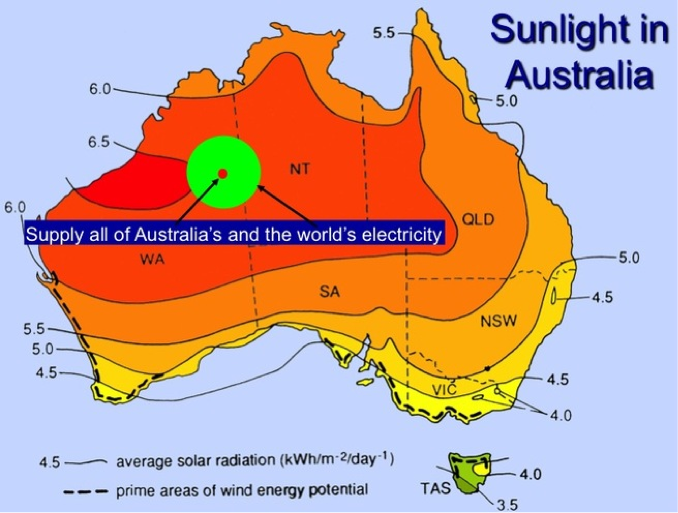Would you believe me if I told you that we could power our nation’s energy use by covering less than 0.01% of Australia with solar panels? It sounds crazy but it’s true. In fact, we could power worldwide energy demand with just 5% of the sunlight reaching our shores. Our sunburnt country is blessed with an abundance of solar energy – energy we can also sell to our neighbours.
 Australia hosts some of the World’s highest solar insolation levels. Image Credit: The Conversation
Australia hosts some of the World’s highest solar insolation levels. Image Credit: The Conversation
A study by Australian and Singaporean researchers has examined the possibility of exporting electricity from Northern Australia to southeast Asia. The peer‑reviewed article, released in 2012, proposes dotting just over 3,000 km2 of outback Australia with high‑efficiency PV modules, specifically for the purpose of exporting electricity to Indonesia, Malaysia, Singapore and Timor‑Leste. The article puts forward the idea of constructing a high voltage direct current (HVDC) ‘super‑grid’ starting from the Northern Territory branching out all over southeast Asia.
Project costing for the outback solar farm predicts the levelised cost of electricity to be in the range of US$0.08 per kilowatt‑hour (kWh) for a 2050 project date, compared to the current wholesale price of US$0.06 per kWh for coal‑fired power in Indonesia. To be clear, costing was conducted without the inclusion of any government subsidies.
In order to export on-demand electricity and moderate generation, the authors also present the idea of establishing a hydrothermal facility used for storing excess energy during the day for export at night. Lake Argyle, Australia’s largest artificial lake, is listed as a possible site both for its capacity and proximity to Asia. It also acknowledges that other energy storage technologies—such as advanced batteries—may develop to become feasible options for a project of this scale by 2050.
The proposal hinges on the ability to construct a high voltage direct current (HVDC) cable to connect Australia to the Asian nations. This poses a significant engineering challenge, especially in the initial connection to Timor as the sea trench separating our two countries dives to 1.8km below sea level at its shallowest passage. The equipment currently used to lay undersea cables can operate to a depth of 1km, however research has suggested that it is technically feasible to operate to depths of 2km.
Energy security will continue to be an important issue for growing southeast Asian populations, set to pass 500 million by 2050 with a total combined land area of less than half of Australia. By establishing this ‘super‑grid’, southeast Asia can reduce its dependence on fossil fuels and diversify its energy mix while Australia benefits from playing a central role in the economic development of its closest neighbours. And all of this before stating the obvious environmental benefits of displacing 500 terawatt‑hours of fossil fuel generated electricity annually.
In light of the recent developments surrounding our Government’s shambolic RET review, proposals like this giant outback solar farm serve to remind us of the benefits inherent to PV as a disruptive technology. PV development can be profitable, it can enable long‑term economic prosperity for our nation and it can generate jobs for everyday Australians.
Top Image Credit: The Conversation
© 2014 Solar Choice Pty Ltd